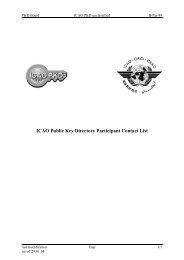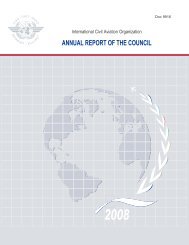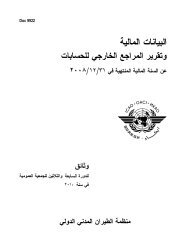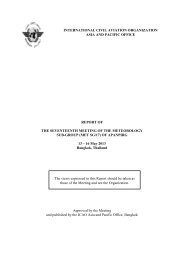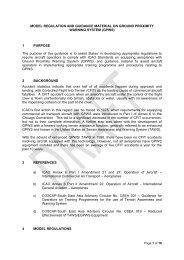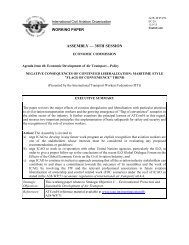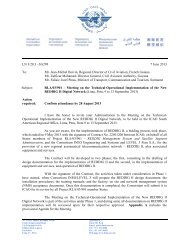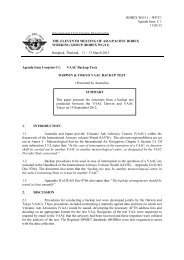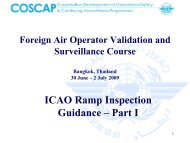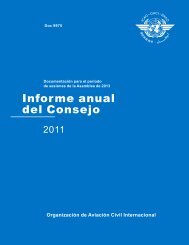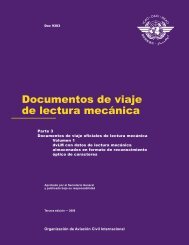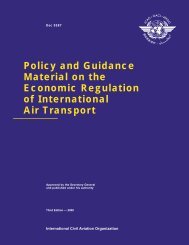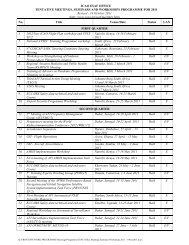Report on Environmental Management System (EMS ... - ICAO
Report on Environmental Management System (EMS ... - ICAO
Report on Environmental Management System (EMS ... - ICAO
You also want an ePaper? Increase the reach of your titles
YUMPU automatically turns print PDFs into web optimized ePapers that Google loves.
<str<strong>on</strong>g>Report</str<strong>on</strong>g> <strong>on</strong> Envir<strong>on</strong>mental <strong>Management</strong><br />
5-2 <strong>System</strong> (<strong>EMS</strong>) Practices in the Aviati<strong>on</strong> Sector<br />
5.2.3 Resp<strong>on</strong>dents indicated that <strong>on</strong>e of the most important reas<strong>on</strong>s why envir<strong>on</strong>mental performance is<br />
measured is to ensure compliance. The questi<strong>on</strong>naire asked participants to list the five most important envir<strong>on</strong>mental<br />
regulati<strong>on</strong>s in which their organizati<strong>on</strong>’s <strong>EMS</strong> ensures compliance. As a result of global participati<strong>on</strong> in the questi<strong>on</strong>naire,<br />
various envir<strong>on</strong>mental regulati<strong>on</strong>s were identified as important, and there was no clear c<strong>on</strong>sensus <strong>on</strong> which laws were<br />
the most significant. The results were therefore categorized into areas of envir<strong>on</strong>mental c<strong>on</strong>cern, which were then tallied<br />
and ranked to identify the top five areas in which the resp<strong>on</strong>dents ensured compliance (see Table 5-2).<br />
Table 5-2. Top five areas of envir<strong>on</strong>mental regulatory c<strong>on</strong>cern<br />
Important envir<strong>on</strong>mental regulati<strong>on</strong> areas<br />
Hazardous/solid waste 54%<br />
Water 40%<br />
Nati<strong>on</strong>al envir<strong>on</strong>mental regulati<strong>on</strong>s 38%<br />
Air 34%<br />
Noise 26%<br />
Note.— Percentages are based <strong>on</strong> 115 resp<strong>on</strong>dents.<br />
5.2.4 First, the management and disposal of hazardous and solid waste was the most important envir<strong>on</strong>mental<br />
area in which 54 per cent resp<strong>on</strong>dent organizati<strong>on</strong>s ensured compliance. Sec<strong>on</strong>d, legislati<strong>on</strong> that regulates the quality,<br />
management and use of storm water, waste water and drinking water was important to 40 per cent. Thirty-eight per cent<br />
indicated that they ensured compliance with the nati<strong>on</strong>al envir<strong>on</strong>mental regulati<strong>on</strong>s of each State in which their<br />
organizati<strong>on</strong> operated. The nati<strong>on</strong>al envir<strong>on</strong>mental regulati<strong>on</strong> that was identified by resp<strong>on</strong>dents typically c<strong>on</strong>trolled<br />
general envir<strong>on</strong>mental c<strong>on</strong>cerns such as envir<strong>on</strong>mental protecti<strong>on</strong> and c<strong>on</strong>servati<strong>on</strong>. The fourth, most important<br />
regulated envir<strong>on</strong>mental area was the quality and management of air emissi<strong>on</strong>s, in particular, carb<strong>on</strong> dioxide, and the<br />
last was noise.<br />
5.2.5 In additi<strong>on</strong> to compliance, resp<strong>on</strong>dents stated that other important reas<strong>on</strong>s to measure envir<strong>on</strong>mental<br />
performance included the tracking and m<strong>on</strong>itoring of progress towards achievement of envir<strong>on</strong>mental objectives and<br />
reporting performance to stakeholders and the public. Resp<strong>on</strong>dent organizati<strong>on</strong>s typically measured performance<br />
through envir<strong>on</strong>mental audits and the use of key performance indicators. The envir<strong>on</strong>mental targets set by resp<strong>on</strong>dents<br />
were directly aligned with the envir<strong>on</strong>mental areas in which organizati<strong>on</strong>s ensured compliance. In general, resp<strong>on</strong>dents<br />
were looking to reduce their c<strong>on</strong>sumpti<strong>on</strong> of energy, waste, water, emissi<strong>on</strong>s and noise, with envir<strong>on</strong>mental targets and<br />
objectives set <strong>on</strong> average at not more than five years ahead.<br />
5.3 COMMUNICATION METHODS<br />
As shown in Figure 5-1, the most comm<strong>on</strong> methods of communicating envir<strong>on</strong>mental performance across all five sectors<br />
are through the use of sustainability or corporate social resp<strong>on</strong>sibility (CSR) reports and through the organizati<strong>on</strong>’s<br />
website. The third most comm<strong>on</strong> method of external communicati<strong>on</strong> employed by airport and ANSP resp<strong>on</strong>dents is to<br />
use community meetings as a forum for informing stakeholders and the public. In c<strong>on</strong>trast, manufacturer, airline and<br />
other resp<strong>on</strong>dents prefer the use of newsletters over community meetings. In all sectors there were some organizati<strong>on</strong>s<br />
that listed other means of communicating envir<strong>on</strong>mental performance, including presentati<strong>on</strong>s at c<strong>on</strong>ferences, internal<br />
meetings, press releases, magazines and other publicati<strong>on</strong>s.



